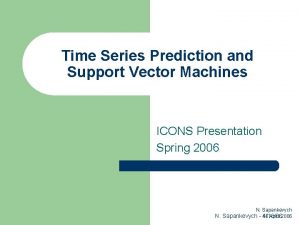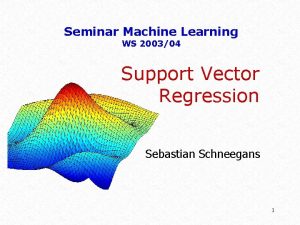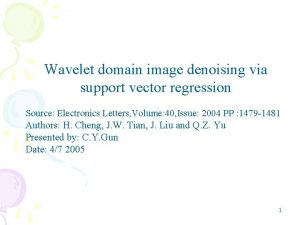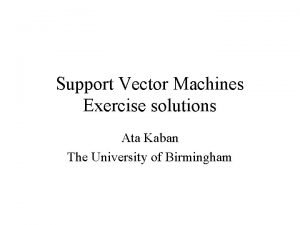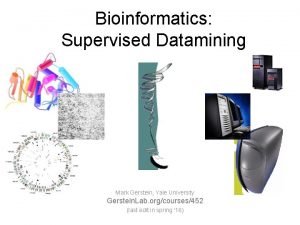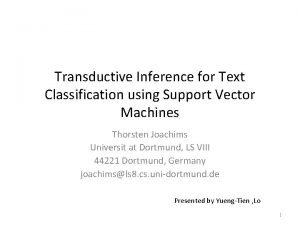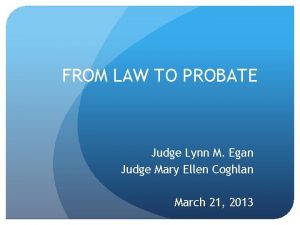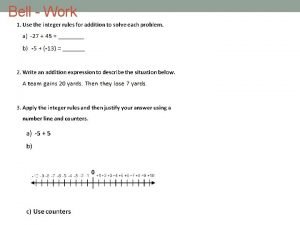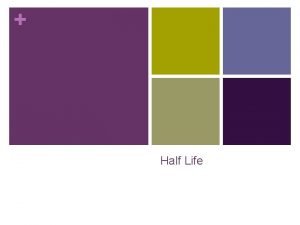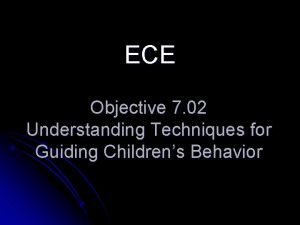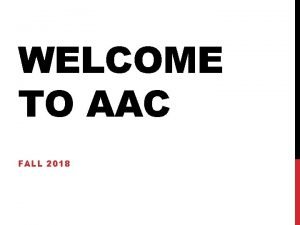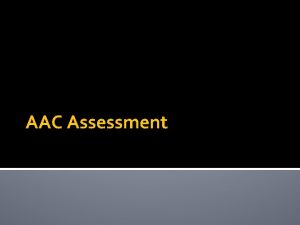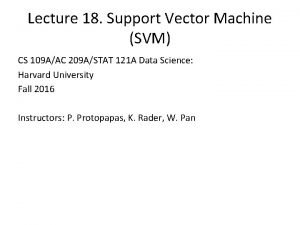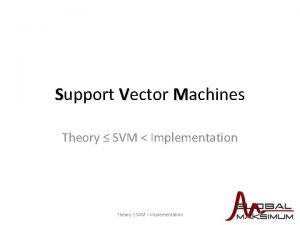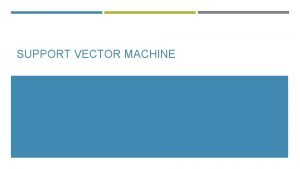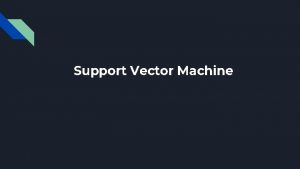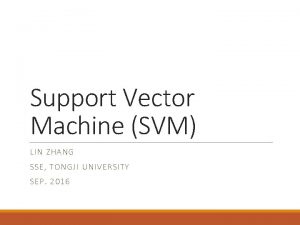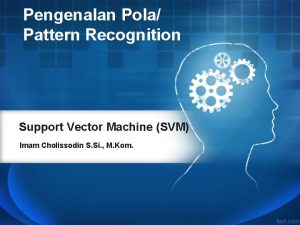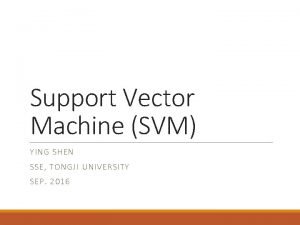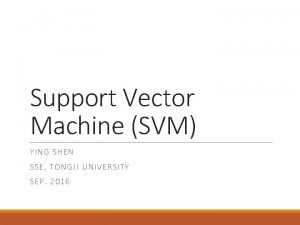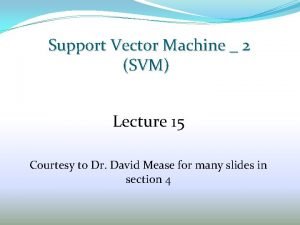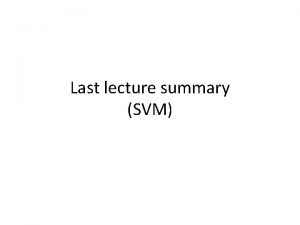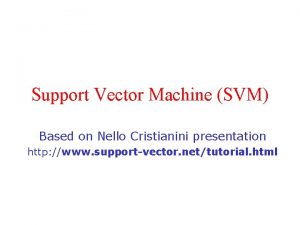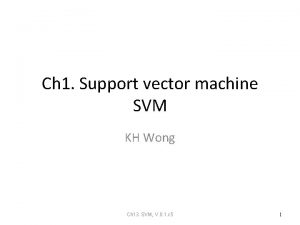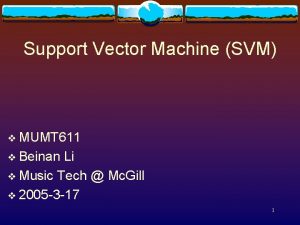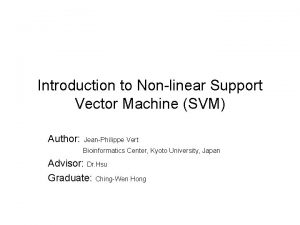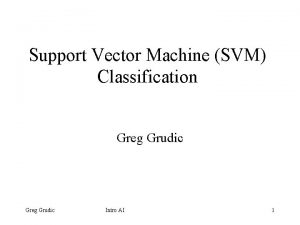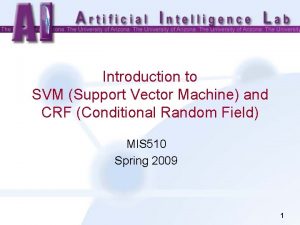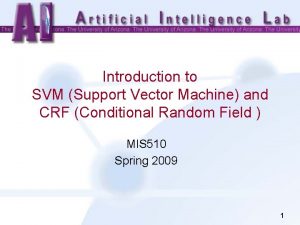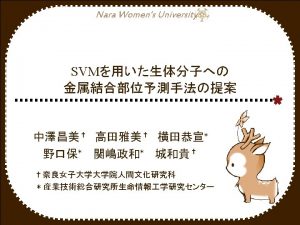Support Vector Machine SVM CS 109 AAC 209






























- Slides: 30

Support Vector Machine (SVM) CS 109 A/AC 209 A/STAT 121 A Data Science: Harvard University Fall 2016 Instructors: P. Protopapas, K. Rader, W. Pan

Announcements Pavlos office hours: Wed 4 -5 will be covered by Hari. HW 7: Due tomorrow midnight HW 8: Q 2 is optional. In-class competition hosted at Kaggle, top 20% will be awarded +1 point applicable to any HW Milestone #4 -5 deadline: Nov 28

Quiz • Code quiz: bernie 2020

Elections • What have we learned? Why the predictions were so off? – Modeling errors? – Methodology? – Data? – People?

Support Vector Machine (SVM) • Support vector machines (SVM) is a classification method from the 90 s that is very popular. • SVMs performs well in a many different applications • One of the best “out of the box” classifiers (as RF or Ada. Boost).

Support Vector Machine (SVM) 1. Maximal margin classifier, a simple and intuitive model that is not useful since it requires that the classes are separable. 2. Support vector classifier is more general and useful classifier, still only allows for linear class boundaries 3. Support vector machine, which is a further extension of the support vector classifier in order to accommodate non-linear class boundaries.

Support Vector Machine (SVM) 1. Maximal margin classifier, a simple and intuitive model that is not useful since it requires that the classes are separable. 2. Support vector classifier is more general and useful classifier, still only allows for linear class boundaries 3. Support vector machine, which is a further extension of the support vector classifier in order to accommodate non-linear class boundaries.

Hyperplane x: data point y: label {-1, 1} w: weight vector w w. Tx=0

Hyperplane x: data point y: label {-1, 1} w: weight vector x 2 w x 1 w. Tx=0

Hyperplane x: data point y: label {-1, 1} w: weight vector b: bias x 2 w b x 1 w. Tx+b=0

Hyperplane x: data point y: label {-1, 1} w: weight vector b: bias x 2 1 w. Tx+b>0 w w. Tx+b<0 -1 w. Tx+b=0 x 1

Maximal Margin Classifier • Can choose many w’s x 2 x 1

Maximal Margin Classifier • Given w, we measure the distances to all points x 2 x 1

Maximal Margin Classifier • Find the smallest such distance (the minimum) the margin for this hyperplane. x 2 x 1

Maximal Margin Classifier • Do that for all possible hyperplanes x 2 x 1

Maximal Margin Classifier The maximal margin hyperplane is the separating hyperplane for which the margin is largest The hyperplane that has the farthest minimum distance to the training observations.

Support vectors

• The maximal margin hyperplane only depends on the support vectors

Maximal Margin Classifier Equation for hyperplale in p dimensions: If The point lies on one side of the hyperplane Lies on the other side

Maximal Margin Classifier If y={-1, 1} then: M represents the margin where and the optimization finds the maximum M

Support Vectors

Support Vectors • What if there is no hyperplane that separates the two classes? x 2 x 1

Support Vectors • What if there is no hyperplane that separates the two classes? x 2 x 1

Support Vectors • Shall we consider a classifier based on a hyperplane that does not perfectly separate the two classes: – Greatest robustness to individual measurements – Better classification of most of the training observations Misclassify a few training observations in order to do a better job in classifying the remaining observations Support vector classifier, aka soft margin classifier, does this

Support Vectors • We consider a classifier based on a hyperplane that does not perfectly separate the two classes: – Greatest robustness to individual measurements – Better classification of most of the training observations Misclassify a few training observations in order to do a better job in classifying the remaining observations Support vector classifier, aka soft margin classifier, does this

Support Vector Classifier

Support Vector Classifier Simply speaking instead of looking at the maximum of the minimum of the distances we redefine the margin not to be the minimum of the distances but we allow some points to be on the other side of the margins or even the other side of the hyperplane. C, a tuning parameter controls how much we allow. If C=0 then we are back to Maximal Margin Classifier (if it is possible) If C>0 we become more tolerant of violations to the margin. C tells us how many points can be violating the margin.

Support Vector Classifier We determine C using Cross-Validation (as usual) and it is again a tradeoff between bias and variance. For very small C (no mistakes) we fit the training set very well but we will not do well in the testing. If C is too large we gave a many hyperplanes that can do the job.


Support Vector Classifier ε 1, . . . , εn are slack variables. If εi > 0 then the i-th observation is on the wrong side of the margin, and we say that the i-th observation has violated the margin. If εi > 1 then it is on the wrong side of the hyperplane.
 Support vector machine icon
Support vector machine icon Support vector machine regression
Support vector machine regression Father of support vector machine
Father of support vector machine Svm exercise solutions
Svm exercise solutions Support vector machine pdf
Support vector machine pdf Transductive support vector machines
Transductive support vector machines Svmsong
Svmsong Structured support vector machine
Structured support vector machine Support vector machine intuition
Support vector machine intuition In my heart there rings a melody
In my heart there rings a melody 735 ilcs 5/13-209
735 ilcs 5/13-209 Lesson 2 add integers page 209 answers
Lesson 2 add integers page 209 answers Ece 209
Ece 209 Participio presente activo griego
Participio presente activo griego Whats half life
Whats half life Ece 209
Ece 209 No tech aac examples
No tech aac examples 18 aac 75
18 aac 75 Coverage vocabulary aac
Coverage vocabulary aac Heaac
Heaac Aac goals
Aac goals Just in time programming aac
Just in time programming aac Aac implementation plan
Aac implementation plan Aac evaluation genie
Aac evaluation genie Aac and apraxia
Aac and apraxia Aac
Aac Aac aids
Aac aids Tertiary aac assessment centre
Tertiary aac assessment centre Crooked house aac
Crooked house aac Aac implementation plan
Aac implementation plan Winamp aac encoder
Winamp aac encoder
